| |
|
Xiamen Oil Paintings, Wholesale Direct!
|
|
100% hand painted, 100% cotton canvas, 100% money back if not satisfaction. |
|
|
|
|
ART WORKS INDEX
A
B
C
D
E
F
G
H
I
J
K
L
M
N
O
P
Q
R
S
T
U
V
W
X
Y
Z
|
|
ARTISTS INDEX
A
B
C
D
E
F
G
H
I
J
K
L
M
N
O
P
Q
R
S
T
U
V
W
X
Y
Z
|
|
|
|
|
|
|
|
|
|
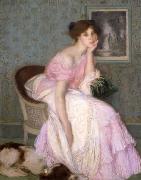 |
Edmond Aman-Jean
|
|
(1858 - 1936) was a French symbolist painter, who founded the Salon des Tuileries. It is also noted that he was a friend of Georges Seurat.
|
|
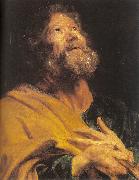 |
Dyck, Anthony van
|
|
Flemish Baroque Era Painter, 1599-1641
Flemish painter and draughtsman, active also in Italy and England. He was the leading Flemish painter after Rubens in the first half of the 17th century and in the 18th century was often considered no less than his match. A number of van Dyck's studies in oil of characterful heads were included in Rubens's estate inventory in 1640, where they were distinguished neither in quality nor in purpose from those stocked by the older master. Although frustrated as a designer of tapestry and, with an almost solitary exception, as a deviser of palatial decoration, van Dyck succeeded brilliantly as an etcher. He was also skilled at organizing reproductive engravers in Antwerp to publish his works, in particular The Iconography (c. 1632-44), comprising scores of contemporary etched and engraved portraits, eventually numbering 100, by which election he revived the Renaissance tradition of promoting images of uomini illustri. His fame as a portrait painter in the cities of the southern Netherlands, as well as in London, Genoa, Rome and Palermo, has never been outshone; and from at least the early 18th century his full-length portraits were especially prized in Genoese, British and Flemish houses,
|
|
|
|
 |
Dirk van der Aa
|
|
Dirk van der Aa , 1731 -- February 23, 1809.
He was born in The Hague, and first apprenticed to Johann Heinrich Keller, and then to Gerrit Mes with whom he would later start a workshop; they specialized in grisaille decorative paintings. He counted Evert Morel, Cornelis Kuipers, Johan Christiaan Roedig and Andries van der Aa amongst his students. He died in his home city of The Hague.
|
|
|
|
|
|
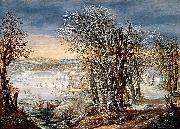 |
Denis van Alsloot
|
|
(Dutch: Denijs van Alsloot) (c. 1570, Mechelen - c. 1626) was a Flemish Baroque painter.
He initially painted using the style of Gillis van Coninxloo, but after 1610 gradually developed a style of his own. This style can be seen in paintings such as The feast of the Ommegang (Museo del Prado, Madrid) and Procession to Mary at the Zavel in Brussels (Victoria and Albert Museum, London).
At the beginning of the 17th century, in either 1600 or 1606, his career rose when he served as court painter to Albert and Isabella.
Hendrick de Clerck sometimes painted the people (Dutch: stoffering or stoffage) in his landscape works.
Van Alsloot's work can be regarded as a precursor to modern Landscape art.
|
|
|
|
|
|
 |
Davies Arthur Bowen
|
|
American Symbolist Painter, printmaker and tapestry designer , b.1862 d.1928
American painter and illustrator. He first trained as an architectural draughtsman at the Academy of Design, Chicago (1878). After studying briefly at the Art Institute of Chicago, he went to New York, where he attended the Gotham School and the Art Students League (1886-8). By 1887 he was working as an illustrator for Century magazine. A realist landscape painter in the 19th-century academic tradition, he was influenced by the painters of the Hudson River school and particularly by the luminist, dream-like landscapes of George Inness.
|
|
|
|
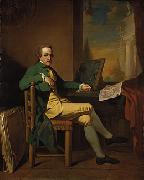 |
David Allan
|
|
13 February 1744 C 6 August 1796) was a Scottish painter, best known for historical subjects.
He was born at Alloa in central Scotland. On leaving Foulis's academy of painting at Glasgow (1762), after seven years' successful study, he obtained the patronage of Lord Cathcart and of Erskine of Mar, on whose estate he had been born. Erskine made it possible for him to travel to Rome (1764), where he remained for several years engaged principally in copying the old masters.
Among the original works which he then painted was the "Origin of Portraiture", now in the National Gallery at Edinburgh--representing a Corinthian maid drawing her lover's shadow--well known through Domenico Cunego's excellent engraving. This won him the gold medal given by the Academy of St Luke in the year 1773 for the best specimen of historical composition.
|
|
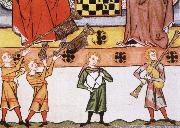 |
dante alighieri
|
|
Born: 1265
Birthplace: Florence, Italy
Died: September 1321 (Malaria)
Best Known As: The author of The Divine Comedy
|
|
|
|
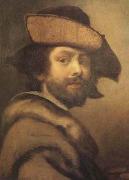 |
Cristofano Allori
|
|
Italian Baroque Era Painter, 1577-1621
was an Italian portrait painter of the late Florentine Mannerist school. Allori was born at Florence and received his first lessons in painting from his father, Alessandro Allori, but becoming dissatisfied with the hard anatomical drawing and cold coloring of the latter, he entered the studio of Gregorio Pagani (1558-1605) who was one of the leaders of the late Florentine school, which sought to unite the rich coloring of the Venetians with the Florentine attention to drawing. Allori also appears to have worked under Cigoli. His pictures are distinguished by their close adherence to nature and the delicacy and technical perfection of their execution. His technical skill is shown by the fact that several copies he made of Correggio's works were thought to be duplicates by Correggio himself. His extreme fastidiousness limited the number of his works. Several specimens are to be seen at Florence and elsewhere. The finest of his works is his Judith with the Head of Holofernes. It exists in two copies in the Pitti Palace in Florence and in the Queen's Gallery in London.
|
|
|
|
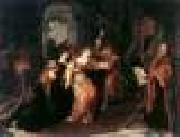 |
COYPEL, Antoine
|
|
French Baroque Era Painter, 1661-1722
director of the French Royal Academy and principal painter of Louis XV. He illustrated many literary works, including editions of Moliere's plays, and was himself a prolific dramatist. Coypel wrote one fairy tale, Agla ou Nabotine (Agla or Little One?), published posthumously in 1779. Coypel weaves several traditional fairy tale motifs into the story of a benevolent fairy who tests the kindness and sincerity of an ugly little girl whose virtue is eventually rewarded with beauty and the love of a handsome young man.
|
|
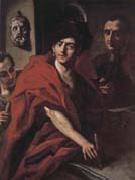 |
Cosmas Damian asam
|
|
1686-1739
Tegernsee, Bavaria died April 29, 1750, Mannheim, Palatinate) Bavarian architects and decorators. After studying in Rome (1711 C 13), Cosmas Damian became a prolific fresco painter, and his brother, Egid Quirin, became a sculptor and stuccoist. They developed the effects of dramatic lighting and illusionism originated by Gian Lorenzo Bernini and Andrea Pozzo. Working as a team, they produced magnificent illusionistic decoration in ecclesiastical buildings, combining dramatic lighting and colour. Their works are notable for their profound and dramatic intensity of religious feeling. The brothers became the principal late Baroque exponents of illusionist decoration in religious architecture. Their most notable collaboration is the church of St. John Nepomuk in Munich
|
|
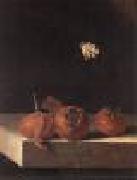 |
COORTE, Adriaen
|
|
Dutch Baroque Era Painter, ca.1660-1707
Dutch painter. He painted mainly small still-lifes, but contrary to the contemporary fashion for increasingly complicated representations of flowers and fruit, he preferred to paint single objects arranged as simply as possible. Coorte's subjects were generally fruit or vegetables, sometimes shells and, more rarely, flowers or vanitas arrangements. These are generally arranged on a stone plinth or slab, often with a crack or groove on the front edge. In the larger paintings the composition is sometimes enclosed in a niche
|
|
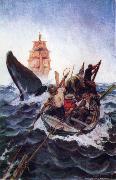 |
Clifford Warren Ashley
|
|
Author, Sailor, and Artist
American
1881-1947
was an American author, sailor, and artist. He is perhaps most famous for The Ashley Book of Knots, an encyclopedic reference manual with directions for and illustrations of thousands of knots. He invented the Ashley's stopper knot. Ashley also wrote The Yankee Whaler, a study of sperm whale hunters in New England in the late 18th century and early 19th century. He was born in New Bedford,
|
|
|
|
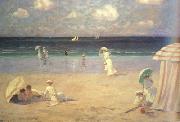 |
Clarence a gagnon
|
|
Canadian Painter, 1881-1942
was a Quebecois painter. A native of Montreal, he studied at the Art Association of Montreal in 1897. Early in life, his mother had encouraged him to learn drawing and painting, but his father wanted him to become a businessman. Desiring to improve his knowledge about art, he went to the Academie Julian, Paris, and studied under Jean-Paul Laurens from 1904 to 1905. He then lived in Baie-Saint-Paul, where he produced many paintings depicting nature and the Canadian people. He invented a new kind of winter landscape that consisted of mountains, valleys, sharp contrasts, vivid colours, and sinuous lines. He became a member of the Royal Academy of the Arts in 1910. Gagnon took a trip to Venice, Rouen, Saint-Malo and the Laurentians to paint landscapes. He illustrated the pages of the novel Maria Chapdelaine by Louis Hemon. As well, he was the illustrator for Louis-Frederic Rouquette in 1929 in the white silence. He lived in France from 1924 to 1936. Gagnon opened modernity painting within Canada. He died in 1942. One of his disciples is the painter Rene Richard.
|
|
|
|
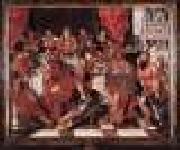 |
CLAEISSENS, Antoon
|
|
Flemish painter (b. ca. 1538, Brugge, d. 1613, Brugge).
Flemish painter and draughtsman. In 1587 he was working in Rome with the Brussels painter Frans van de Kasteele. That he subsequently lived in Brussels is confirmed by documentary evidence and by his status as court painter to the governors of the southern Netherlands. Stylistically, de Clerck's work (both paintings and drawings) is close to that of the Antwerp late Mannerist Marten de Vos, traditionally thought to have been his teacher, but it is possible that he was apprenticed to Joos van Winghe in Italy. He was later a member of the Brussels painters' guild, where from 1601 to 1611 Jan van Overstraeten was registered as his pupil. It was in 1594 that de Clerck was appointed court painter in Brussels, first to Archduke Ernest. In 1596, after the Archduke's death, his brother Emperor Rudolf II arranged for de Clerck to stay on as court painter in the service of the new Archdukes, Albert and Isabella. In 1609 de Clerck and Wenceslas Cobergher were commissioned to decorate the ceiling of the oratorium in the archducal palace in Brussels
|
|
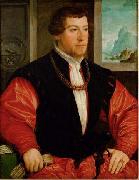 |
Christoph Amberger
|
|
(c. 1505 --1562) was a painter of Nernberg in the 16th century, a disciple of Hans Holbein, his principal work being the history of Joseph in twelve pictures.
Amberger travelled to Northern Italy and Venice between 1525 and 1527. He died in Augsburg.
|
|
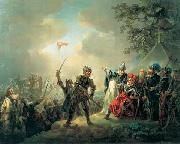 |
Christian August Lorentzen
|
|
(10 August 1749 - 8 May 1828) was a Danish painter. He was the instructor of Martinus Rørbye.
Christian August Lorentzen was born on 10 August 1749 as the son of a watchmaker. He arrived in Copenhagen around 1771 where he frequented the Royal Academy of Fine Arts but it is unclear whether he received formal training.From 1779 to 1782 he want abroad to develop his skills, visiting the Netherlands, Antwerp and Paris where he copied old masters. In 1792 he traveled to Norway to paint prospects.
In a number of painting, such as Slaget på Reden (1801, Danish Museum of National History and Den rædsomste nat (1807, Danish National Gallery, he documented key events from the English Wars between 1801 and 1814. Later in his career he mainly painted portraits, landscapes and scenes from Ludvig Holberg's comedies.
As a professor at the Royal Academy in Copenhagen from 1803 and until his death in 1828, he exercisized great influence on the next generation of painters such as Martinus Rørbye among others.
|
|
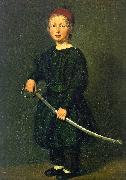 |
Christian Albrecht Jensen
|
|
1792-1870
Danish
Christian Albrecht Jensen Galleries
1792-1870
Danish
Christian Albrecht Jensen Galleries
was a Danish painter, born in Bredstedt, Nordfriesland. In 1818, he traveled to Rome, and met the sculptor Bertel Thorvaldsen. His work is representative of the Golden Age of Danish Painting.
|
|
|
|
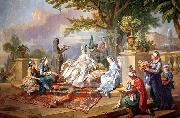 |
Charles-Amedee-Philippe van Loo
|
|
(25 August 1719 -15 November 1795) was a French painter of allegorical scenes and portraits.
He studied under his father, the painter Jean-Baptiste van Loo, at Turin and Rome, where in 1738 he won the Prix de Rome, then at Aix-en-Provence, before returning to Paris in 1745. He was invited to join the Academie Royale de Peinture et de Sculpture in 1747, and that year he married his cousin Marie-Marguerite Lebrun, daughter of the painter Michel Lebrun (died 1753).
Among his brothers were the painters François van Loo (1708-1732) and Louis-Michel van Loo (1707-1771).
|
|
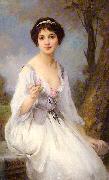 |
Charles-Amable Lenoir
|
|
(22 October 1860 - 1926) was a French painter. Like his mentor, William-Adolphe Bouguereau, he was an academic painter and painted realistic portraits as well as mythological and religious scenes. His artistic career was so prestigious that he won the Prix de Rome twice and was awarded the Legion d'honneur.
Lenoir was born in Châtellaillon, a small town just outside of La Rochelle. His mother was a seamstress and his father was a customs officer. When he was young, his father was reassigned and the family moved to Fouras. He did not start out in life as an artist, but instead began his education at a teachers' college in La Rochelle. Upon graduation, he worked as a teacher and supervisor at the lycee in Rochefort.
In August 1883 he was accepted into the École des Beaux-Arts de Paris, he also joined the Academie Julian where he was a student of William-Adolphe Bouguereau and Tony Robert-Fleury. Lenoir made his artistic debut at the Salon in 1887 and continued to exhibit there until his death. He was quickly noticed in the art world, and in 1889 won the Second Prix de Rome for his painting, Jesus et le paralytique (Jesus and a Sick Man with Palsy), and he won the First Prix de Rome the following year for Le Reniement de Saint Pierre (The Denial of St. Peter).His awards did not stop with the Prix de Rome; works shown at the Salons also won prizes, and he received a third-class medal in 1892 for Le Grenier a Vingt Ans (The Garret at twenty years) and a second-class medal in 1896 for La Mort de Sappho (The Death of Sappho).
|
|
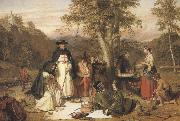 |
Charles landseer,R.A.
|
|
1799-1879
Painter, brother of Thomas Landseer. He trained initially with his father John Landseer, then under Benjamin Robert Haydon, and in 1816 he attended the Royal Academy Schools in London. In 1823 he accompanied Sir Charles Stuart de Rothesay (1779-1845) aboard HMS Wellesley on a voyage to Portugal and then to Brazil, in order to negotiate a commercial treaty with Pedro I, Emperor of Brazil (reg 1822-31). Many of the drawings he made on this trip were exhibited in 1828 at the British Institution, and in that year he sent his first painting to the Royal Academy. This was Dorothea, illustrating a scene from Cervantes's Don Quixote. He continued to exhibit at the Academy until his death, showing mostly romanticized history paintings or such literary subjects as Clarissa Harlowe in the Sponging House from Samuel Richardson's novel Clarissa (London, 1748). The English Civil War (1642-51) was of particular interest to him, his devotion to such historical subjects perhaps being attributable to the influence of his years with Haydon. He also painted portraits, genre scenes and animal studies . In 1837 he was elected ARA and in 1845 RA. In 1851, probably due to the influence of his brother Edwin, he succeeded George Jones as Keeper of the Royal Academy Schools. Responsible for instructing the antique class, his tenure was criticized both for the way his position had been obtained and for the deficiency of his teaching, and he retired from the Keepership in 1873 on full salary.
|
|
|
|
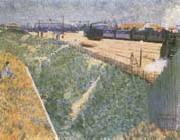 |
Charles Angrand
|
|
French Pointillist Painter, 1854-1926.French painter. He was trained at the Acad?mie de Peinture et de Dessin in Rouen, where he won prizes. Although he failed to gain entry to the Ecole des Beaux-Arts in Paris, Angrand began to win a controversial local reputation for canvases in a loosely Impressionist manner. In 1882 he secured a post as a schoolteacher at the Coll?ge Chaptal in Paris. With this security he was able to make contacts in progressive artistic circles, and in 1884 he became a founder-member of the Salon des Ind?pendants. His paintings of this period depict rural interiors and kitchen gardens, combining the broken brushwork of Monet and Camille Pissarro with the tonal structure of Bastien-Lepage (e.g. In the Garden, 1884; priv. col., see 1979 exh. cat., p. 27).
|
|
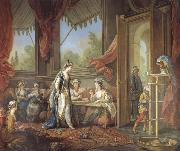 |
Charles Amedee Philippe Van Loo
|
|
French Painter, 1719-1795, was a French painter of allegorical scenes and portraits. He studied under his father, the painter Jean-Baptiste van Loo, at Turin and Rome, where in 1738 he won the Prix de Rome, then at Aix-en-Provence, before returning to Paris in 1745. He was invited to join the Academie Royale de Peinture et de Sculpture in 1747, and that year he married his cousin Marie-Marguerite Lebrun, daughter of the painter Michel Lebrun (died 1753). Among his brothers were the painters Francois van Loo (1708-1732) and Louis-Michel van Loo (1707-1771).
|
|
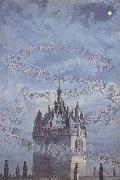 |
Charles Altamont Doyle
|
|
1832-1893
was a Victorian artist. He was the brother of the artist Richard Doyle, and the son of the artist John Doyle. Although the family was Irish, Doyle was born and raised in England. In 1849 he moved to Edinburgh where he met Mary Foley. They were married on 31 July 1855. Their children included Arthur Conan Doyle, creator of Sherlock Holmes, John Francis Innes Hay Doyle (known as Innes or Duff), and Jane Adelaide Rose Foley n??e Doyle (known as Ida). Doyle was not as successful an artist as he wished, and suffered depression and alcoholism. His paintings, which were generally of fairies, such as "A Dance Around The Moon", or similar fantasy scenes, reflected this, becoming more macabre over time. In 1881 Doyle was committed to a nursing home specialising in alcoholism. While there, his depression grew worse, and he began suffering epileptic seizures. Following a violent escape attempt he was sent to Sunnyside, Montrose Royal Lunatic Asylum, where he continued to paint. He died in Crighton Royal Institution in 1893.
|
|
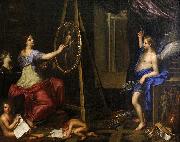 |
Charles Alphonse du Fresnoy
|
|
(1611C1665), French painter and writer on his art, was born in Paris, son of an apothecary.
He was destined for the medical profession, and well educated in Latin and Greek; but, having a natural propensity for the fine arts, he would not apply to his intended vocation, and was allowed to learn the rudiments of design under Perrier and Vouet. At the age of twenty-one he went off to Rome, with no resources; he drew ruins and architectural subjects.
After two years thus spent he re-encountered his old fellow-student Pierre Mignard, and by his aid obtained some amelioration of his professional prospects. He studied Raphael and the antique, went in 1633 to Venice, and in 1656 returned to France. During two years he was now employed in painting altar-pieces in the château du Raincy, landscapes, etc. His death was caused by an attack of apoplexy followed by palsy; he expired at Villiers-le-Bel, near Paris. He never married.
His pictorial works are few; they are correct in drawing, with something of the Caracci in design, and of Titian in colouring, but wanting fire and expression, and insufficient to keep his name in any eminent repute.
He is remembered now almost entirely as a writer rather than painter. His Latin poem, De arte graphica, was written during his Italian sojourn, and embodied his observations on the art of painting; it may be termed a critical treatise on the practice of the art, with general advice to students. The precepts are sound according to the standard of his time; the poetical merits slender enough. The Latin style is formed chiefly on Lucretius and Horace.
|
|
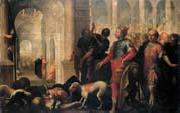 |
CELESTI, Andrea
|
|
Italian painter, Venetian school b. 1637, Venezia, d. 1712, Venezia,Italian painter. He trained first with Matteo Ponzoni, then with Sebastiano Mazzoni; Mazzoni encouraged the development of a Baroque style, but Celesti was also attracted by the naturalism of the tenebrists. The first known works by Celesti are mature in style, and he had already achieved considerable fame in Venice when the Doge Alvise Contarini honoured him with the title of Cavaliere in 1681. The complexity of his sources is evident in two canvases, Moses Destroying the Golden Calf and Moses Chastising the Hebrew People for their Idolatry, both painted c. 1681 for the Palazzo Ducale, Venice, and signed Cavaliere; they are influenced by Luca Giordano and by the narrative techniques of Jacopo Tintoretto. The most distinguished works of Celesti's early period are two large lunettes that show three scenes: Benedict III Visiting St Zacharias, A Doge Presented with the Body of a Saint, and the Virtues Surrounding a Doge Holding the Model of St Zacharias (c. 1684; Venice, S Zaccaria). These luxuriant compositions represent a remarkable leap in quality from the paintings of the Palazzo Ducale, with lighter colours and a more flickering touch. A little later Celesti left Venice for Brescia, perhaps by way of Rovigo; exactly when he arrived is not known, but he established himself and his studio there for several years. Panfilo Nuvolone and Francesco Paglia (1636-1713) had encouraged the development of a more exuberant Baroque style in Brescia, and in response Celesti created more decorative, lyrical works, such as his ecstatic St Rose of Lima (Brescia, S Clemente) with its brilliant display of glorious light. Most of Celesti's paintings done in and around Brescia were religious canvases, but he also painted portraits, such as the two entitled Condottiero (Ljubljana, Slov. Acad. Sci. & A.) and the portrait of Conte Alberto di Baone (Dublin, N.G.), executed in a dazzling array of colours. In 1688 Celesti was active at Toscolano on Lake Garda, where he painted canvases of scenes from the Life of St Peter (Toscolano Cathedral) and in 1689 decorated the salone of the Palazzo Delay (now Palazzo Mafizzoli) with Old Testament scenes. In 1696 he was at Treviso, where he executed a Last Judgement for the cathedral (untraced) and in 1697, 1698 and 1699 pictures for the abbey of S Floriano at Linz, where his Paradise, for the high altar, remains in situ. By 1700 Celesti was back in Venice, where he set up his studio; Venetian artists of this period, led by Giovanni Coli and Filippo Gherardi, were reviving the style of Veronese, and Celesti, following this trend, produced late works that employed more dazzling effects of colour and light. These works include the frescoed decoration of the Villa Rinaldi Barbini at Casella d'Asolo, where Celesti created a series of exotic and theatrical mythological and biblical scenes, distinguished by their luminosity and by their light and airy touch. His last works were three dramatic night scenes: the Birth of the Virgin, the Assumption of the Virgin and the Martyrdom of St Lawrence (1706-11; Verolanuova Cathedral). Celesti was much admired by Charles-Nicholas Cochin (i) and by Jean-Honor? Fragonard, and his colour influenced the Rococo art of the early 18th century in Venice and in Austria.
|
|
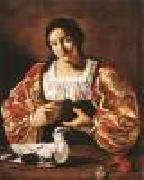 |
CECCO DEL CARAVAGGIO
|
|
Italian Baroque Era Painter, active ca.1610-1620
Painter active in Italy. His nationality is not known. He was a follower of Caravaggio, and his rare works reveal a highly original and idiosyncratic response to that artist's naturalism. Agostino Tassi mentioned him as involved, with several French artists, in the decoration of the Villa Lante at Bagnaia between 1613 and 1615,
|
|
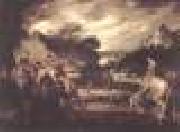 |
CASTILLO, Antonio del
|
|
b. 1616, Cordoba, d. 1668, Cordoba
Spanish painter and draughtsman. He studied first with his father, Agust?n del Castillo (d July 1631), a painter also known for his drawings, and in November 1631 began a three-year apprenticeship with Ignacio de Aedo Calderen, a painter of religious figures ( pintor de imaginera). From 1635 to 1638 Castillo was also known as painter and pintor de imaginera, and by December 1638
|
|
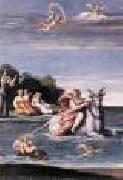 |
CARRACCI, Antonio
|
|
Italian Baroque Era Painter, ca.1583-1618
Painter, son of Agostino Carracci. He was born either c. 1583 (Baglione) or in 1589 (Bellori). His mother was a Venetian courtesan named Isabella. After his father's death, he joined the Roman household of his uncle Annibale Carracci. While Antonio may have collaborated with other studio assistants on the wall frescoes (1603-4) of the Galleria Farnese and the decoration (1606; commissioned from Francesco Albani) of some rooms in the Palazzo Mattei di Giove, Rome, his earliest undisputed works date from after Annibale's death in 1609. At that time, according to Monsignor G. B. Agucchi (Malvasia), Antonio returned briefly to Bologna, with the intention of joining Ludovico Carracci's studio, but the proposed collaboration came to nothing. A frescoed Vision of St Francis in the lower oratory of S Colombano was most probably painted during this Bolognese sojourn, and his Burial of Christ (Rome, Gal. Borghese) dates from c. 1609. He returned to Rome in 1610 and assisted Guido Reni in the Pauline Chapel of the Palazzo del Quirinale, where he painted Virtues and other subsidiary figures on the walls.
|
|
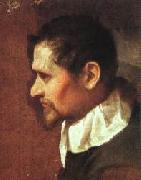 |
CARRACCI, Annibale
|
|
Italian Baroque Era Painter, 1560-1609
Painter, draughtsman and printmaker, brother of Agostino Carracci. Since his lifetime, he has been considered one of the greatest Italian painters of his age. His masterpiece, the ceiling (1597-1601) of the Galleria Farnese, Rome, merges a vibrant naturalism with the formal language of classicism in a grand and monumental style.
|
|
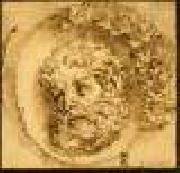 |
CARRACCI, Agostino
|
|
Italian Baroque Era Painter, 1557-1602
Painter, engraver and draughtsman, cousin of Ludovico Carracci. He abandoned his profession as a tailor, which was also that of his father, Antonio, and began training as a painter. According to Faberi, he studied first in the workshop of the painter Prospero Fontana (like Ludovico), then trained under the engraver and architect Domenico Tibaldi and under the sculptor Alessandro Menganti (1531-c. 1594). However, it is likely that Faberi's account was influenced by his desire to present Agostino's career as an example of the versatile 'cursus studiorum' advocated by the Accademia degli Incamminati. Other sources (Mancini, Malvasia, Bellori) agree that it was his cousin Ludovico who was responsible for directing him towards painting.
|
|
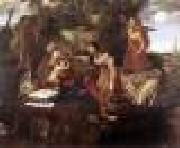 |
CAROSELLI, Angelo
|
|
Italian painter, Roman school (b. 1585, Roma, d. 1652, Roma)
Italian painter. He was the son of a dealer in second-hand goods and taught himself to paint. According to Baldinucci, he knew Caravaggio, who fled Rome in 1606, and this association may have encouraged his decision to become a painter. After visits to Florence (1605) and Naples (1613), Caroselli settled in Rome, where, in 1615, he married a Sicilian, Maria Zurca. His weakness for beautiful women was notorious (Baldinucci; Passeri). His second marriage, to Brigitta Lauri, daughter of the Flemish painter Balthasar Lauwers or Lauri (1578-1645),
|
|
|
|
 |
Carnicero, Antonio
|
|
Spanish, approx. 1748-1814
Painter and draughtsman, son of Alejandro Carnicero. He arrived at the Court in Madrid with his father in 1749 and took part in the competitions held by the Real Academia de S Fernando, winning second prize in 1769 with the Coronation of Alfonso XI and Queen Mary in the Monastery of Huelgas de Burgos (Madrid, Real Acad. S Fernando, Mus.). In 1760 he won a scholarship to Rome, subsequently winning prizes from the Accademia di S Luca. On his return to Madrid in 1766 he worked as a portrait painter, producing works such as the portrait of Do?a Tomasa de Aliaga, Widow of Salcedo (Madrid, Prado). In 1788 he was elected an honorary member of S Fernando. Under the protection of the Spanish prime minister, Manuel Godoy, Prencipe de la Paz, whom he painted on several occasions , and after painting the portraits of Charles IV and Maria Luisa (both Madrid, Monasterio de la Encarnacien), he was appointed Pintor de Cemara in 1796. In 1798 he applied unsuccessfully for the post of drawing-master to the Prince of Asturias, the future Ferdinand VII, although by 1806 he was teacher of the Infante Princes. He was a refined draughtsman and prepared illustrations for the editions of Cervantes's El ingenioso hidalgo Don Quixote de la Mancha published by the Real Academia Espa?ola (Madrid, 1780; 1782). He also made the drawings for the handsome engravings (Madrid, Calcografra N.) of the Real Picadero (Royal Riding School). In addition to his portraiture, which displays a talent for realism and wit, although at times combined with slightly garish colours, Carnicero executed attractive and descriptive costumbrista paintings, depicting everyday life, popular gatherings and hunting scenes, for instance Duck Shooting on the Albufera, Valencia
|
|
|
|
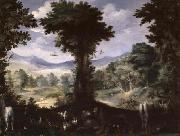 |
Carlo Antonio Procaccini
|
|
(born 1555) was an Italian painter of the late-Renaissance period.
He was the third son of Ercole, the brother of Camillo and Giulio Cesare the elder, and father of Ercole Procaccini the Younger (1605?C1675). He was born at Bologna and initially trained by his father, though he excelled in painting landscapes and still-lifes with flowers and fruit, mainly in Milan.
|
|
|
|
|
|
|
|
|
| Wholesale China Oil Painting Wholesale Oil Painting China Xiamen Portrait Reproduction on canvas Chinese Oil Painting Wholesale USA Oil Painting |
|
|
|
|
|